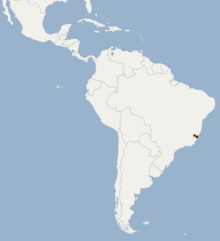Dryadonycteris capixaba is a species of leaf-nosed bat found in South America. It is the only species within the genus Dryadonycteris.
| Dryadonycteris capixaba | |
|---|---|
| Scientific classification | |
| Domain: | Eukaryota |
| Kingdom: | Animalia |
| Phylum: | Chordata |
| Class: | Mammalia |
| Order: | Chiroptera |
| Family: | Phyllostomidae |
| Genus: | Dryadonycteris Nogueira, Lima, Peracchi, & Simmons, 2012 |
| Species: | D. capixaba
|
| Binomial name | |
| Dryadonycteris capixaba | |

| |
| Range of D. capixaba | |
Taxonomy and etymology
editIt was described as a new species in 2012. It was described in part from museum specimens that had been identified as the lesser long-tongued bat. The holotype was collected in 2011 in Linhares, Brazil. It is within the subfamily Glossophaginae. The genus name Dryadonycteris was derived from Carl Friedrich Philipp von Martius's name for Atlantic Forest, "Dryades." "Dryades" was derived from Greek dryad, or "wood nymph." "Dryadonycteris" literally means "bat from Dryades," here meaning Atlantic Forest. The species name "capixaba" is from the Tupia language meaning "a native of the state of Espírito Santo."[2]
Description
editIt is similar in appearance to Lichonycteris and Choeroniscus species.[3] It is a small member of Glossophaginae, with a forearm length of 29–32 mm (1.1–1.3 in). It has a triangular nose-leaf. Its tail is short at about 6.5 mm (0.26 in). It has a dental formula of 2.1.2.30.1.3.3 for a total of 30 teeth.[2]
Biology and ecology
editIt is nectarivorous.[2]
Range and habitat
editIt is currently only known from Brazil. It has been documented at elevations of 60 m (200 ft) and 750 m (2,460 ft) above sea level.[3]
References
edit- ^ Solari, S. (2020) [amended version of 2019 assessment]. "Dryadonycteris capixaba". IUCN Red List of Threatened Species. 2020: e.T88120233A166613008. doi:10.2305/IUCN.UK.2020-1.RLTS.T88120233A166613008.en. Retrieved 17 July 2020.
- ^ a b c Nogueira, Marcelo R; Lima, Isaac P; Peracchi, Adriano L; Simmons, Nancy B (2012). "New Genus and species of nectar-feeding bat from the Atlantic Forest of southeastern Brazil (Chiroptera: Phyllostomidae: Glossophaginae)" (PDF). American Museum Novitates (3747): 1–30. doi:10.1206/3747.2. hdl:2246/6180. S2CID 84718763.
- ^ a b Rocha, P. A.; Feijó, A.; Dias, D.; Mikalauskas, J.; Ruiz-Esparza, J.; Ferrari, S. F. (2014). "Major extension of the known range of the capixaba nectar-feeding bat, Dryadonycteris capixaba (Chiroptera, Phyllostomidae). Is this rare species widely distributed in eastern Brazil?". Mastozool Neotrop.
